Your Cart is Empty
Menu

Best Ebike Conversion Kits: The Ultimate Guide
July 23, 2025

Starting your eco-friendly journey doesn't have to mean buying a brand-new electric bike. For cycling enthusiasts and casual riders alike, e-bike conversion kits offer a smart, affordable alternative to purchasing a new e-bike. These kits transform your trusty bicycle into a pedal-assist powerhouse, helping you conquer hills, tackle longer commutes, and rediscover the joy of riding without breaking the bank.
Key Takeaways:
- Converting your existing bicycle with an e-bike conversion kit offers a cost-effective and environmentally friendly way to enhance your cycling experience.
- The best e-bike conversion kit depends on your needs, but top choices are the Cytronex, Bafang, and Swytch kits.
- Always prioritize safety by wearing a helmet, familiarizing yourself with e-bike laws in your area, and starting with gradual power assist.
In this article, we'll explore how e-bike conversion kits work, review some of the best options on the market, and provide tips on installation and maintenance to help you make the most of your upgrade.
What are E-Bike Conversion Kits?
E-bike conversion kits are complete sets of parts, usually including a motor, battery, and controller, that let you convert a regular bicycle into an electric bike with electric-assisted pedaling. Essentially, you're adding a motor, a battery, and a few extra bits to give your rides a welcome boost.
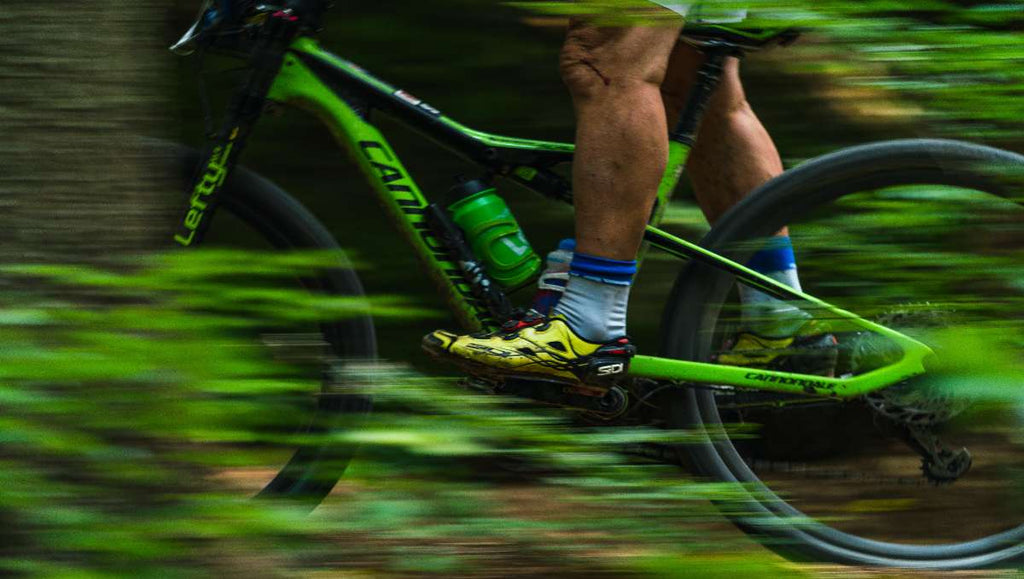
Let's break down the basics:
Types of Kits
There are three main categories of e-bike conversion kits. Each offers different advantages and works in slightly different ways:
- Front-wheel kits:The front wheel of your bike is replaced with a wheel that has a built-in electric motor(within the hub). When activated, the motor spins the front wheel, essentially pulling you along. This is often the most affordable and easiest to install but it can affect steering and handling slightly. This might not be ideal for very hilly terrain.
- Rear-wheel kits:Similar to the front-wheel kit, the motor is integrated into the rear wheel. This kit propels you from behind. It provides a more natural "pushing" sensation, better for tackling hills, but the installation can be a bit more complex than that of front-wheel kits.
- Mid-drive kits:This type replaces your bike's bottom bracket (where the pedals and cranks connect) with a unit containing the motor. The motor directly assists your pedaling, working through your bike's existing gears. This kit offers the most seamless integration and natural riding feel, excellent for hilly areas. However, this is the most expensive and often the most complex to install.
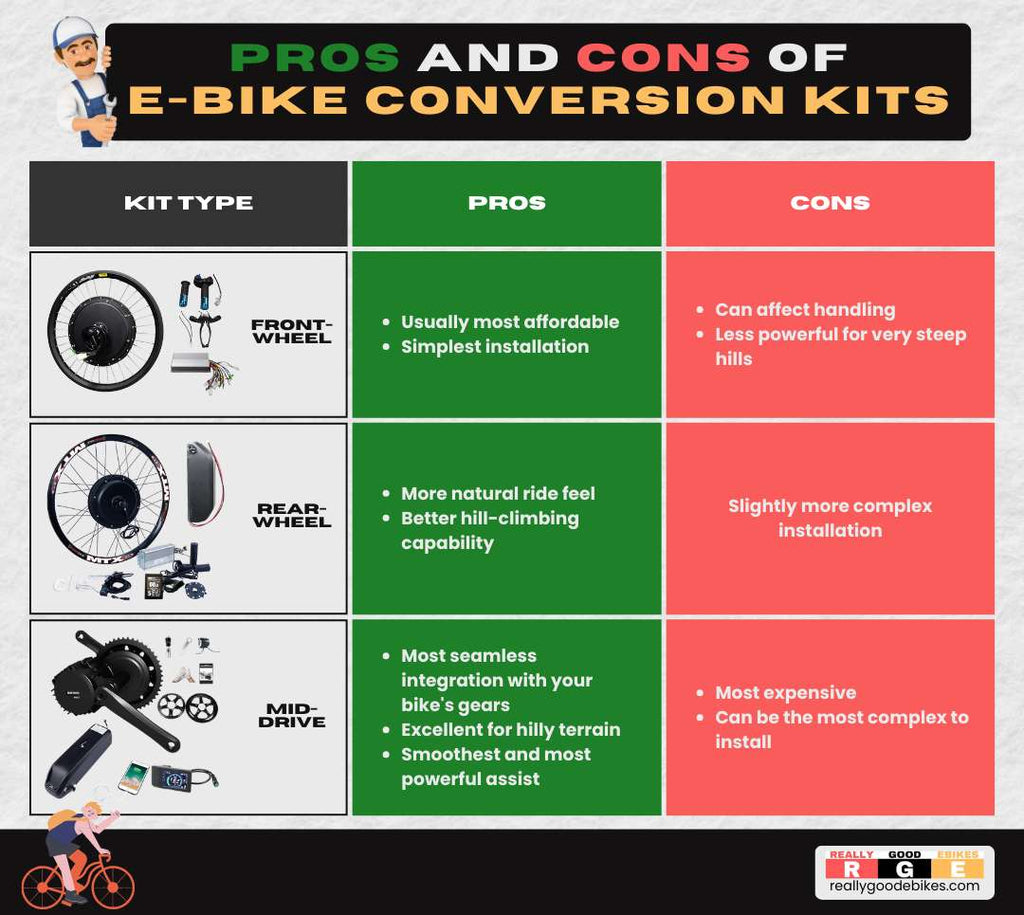
Components
The heart of an e-bike conversion kit lies in its core components, working together to transform your regular bike into an electric-assist machine. Understanding these components will help you compare kits, make informed decisions about power and range, and ultimately get the most out of your e-bike experience.
Motor
The powerhouse of your e-bike, the motor provides the extra boost that makes cycling easier and potentially faster. Motor power is measured in watts (W), with typical options ranging from 250W for basic assistance to 1000W or more for serious hill-climbing and higher speeds. Torque, measured in Newton-meters (Nm), is another critical factor, helping you accelerate from a standstill and conquer those tough inclines.
According to Al Amin Morshed, founder of BoltBikers.com, a platform dedicated to e-bikes and gear upgrades:
“Motor type and placement: Front hub kits like Swytch are easiest to install, but if you're riding hilly terrain or carrying cargo, a mid-drive with torque sensing will feel far more natural.”
Battery
The fuel for your motor, the battery in an e-bike conversion kit, is key to determining how far you can ride on a single charge. Battery capacity is measured in amp-hours (Ah) or watt-hours (Wh), with higher numbers translating to a longer range. However, range can vary widely depending on the power of your motor, the terrain you're riding on, your own weight, and the level of pedal assist you choose. Morshed adds a caution on battery setup:
“Battery integration and power delivery: A poorly balanced battery can throw off handling. For example, rear rack batteries often affect bike stability, while oversized down-tube batteries can interfere with pedaling on smaller frames.”
Controller
Think of the controller as the brains of your e-bike system. It works behind the scenes, controlling the flow of power between your battery and the motor and responding to your input from either the throttle or pedal-assist sensors.
Display
The display unit is your dashboard, giving you real-time information about your ride. Depending on the kit, it might show your speed, battery level, the current pedal-assist mode, and sometimes even additional data like distance traveled or estimated range.

Throttle/Pedal Assist
This determines how you interact with your e-bike's power. A throttle system lets you engage the motor using a twist grip or thumb lever throttle, perfect for those moments when you need a quick boost or want to take a break from pedaling. Pedal assist systems (PAS) sense your pedaling effort and respond automatically, making your natural pedal strokes feel amplified and easier. Many e-bike conversion kits offer both options, including an type of electric bike throttle, letting you choose how you want to ride.
Compatibility
Not every bike is suitable for an e-bike conversion kit. When planning an e-bike conversion, you need to consider several key compatibility factors.
The type of bike matters:Most standard bikes can be converted, but mountain bikes, hybrids, and cruiser bikes are especially good choices due to their sturdy frames designed for various terrains. However, road bikes with ultra-light frames are generally only suitable for smooth roads. Additionally, full-suspension mountain bikes are often difficult to convert because of their complex rear suspension systems.
Wheel size is crucial: Conversion kits typically accommodate common sizes like 26-inch, 27.5-inch, 28-inch, and 700c wheels. For detailed information on this wheel size, check out the 700C e-bike wheel guide. Kits for less common sizes may be harder to find. The perfect 700C wheels for e-bike conversion provide a balanced ride, suitable for both urban commuting and longer distance rides.
The bike's frame is important: Steel and aluminum frames are preferred for their durability and strength. Carbon fiber frames are usually not recommended because they may not withstand the stress from a motor. It's important to check the dropouts (where the wheels attach), as stronger, thicker dropouts are better able to handle the motor's power.
Consider the brakes:Disc brakes, whether hydraulic or mechanical, are recommended for the additional stopping power required for an e-bike. If your bike has rim brakes, they may suffice, but consider upgrading the brake pads for better performance.
Morshed highlights a common mistake:
“Electrical system compatibility: Many riders assume 36V and 48V systems are interchangeable, but mixing voltages between controllers and motors can cause overcurrent issues or throttle lag.”
5 Best Ebike Conversion Kits of 2024
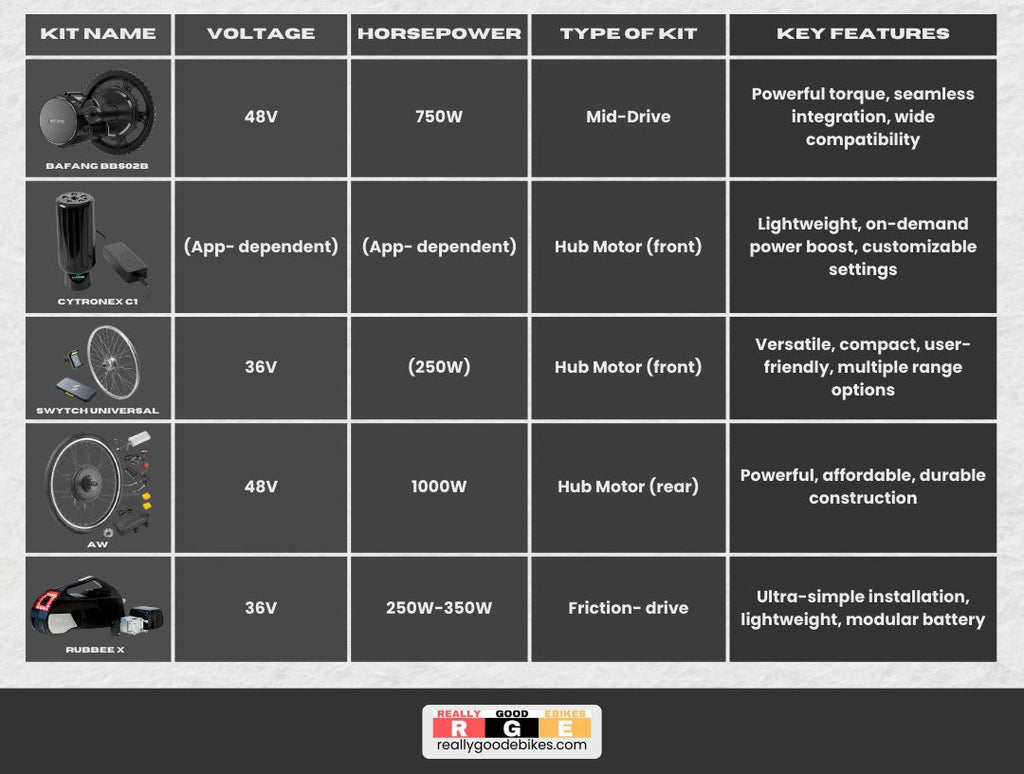
Choosing the right e-bike conversion kit is a big decision. To help you make the best choice, here are some of the top-rated kits on the market, considering factors like power, ease of installation, reliability, and value for money.
1. BAFANG Mid-Drive Ebike Conversion Kits
BAFANG is a well-known name in the e-bike world, trusted for its powerful and customizable conversion kits. They offer both mid-drive and hub motor systems, giving riders options based on terrain, budget, and riding style. Popular mid-drive models like the BBS02B and BBSHD are known for their strong hill-climbing ability and smooth gear integration, while their hub motors provide a more affordable, beginner-friendly alternative.
What sets BAFANG apart is its wide compatibility and performance. The BBS02B fits most standard bike frames with a 68–73mm bottom bracket (and options for 100mm), making it a go-to for mountain and road bikes alike. With motor options up to 1000W and speeds exceeding 25 mph, BAFANG kits deliver serious torque and versatility. Installation is manageable thanks to detailed guides, and riders can enjoy three modes—pure electric, pedal-assist, or traditional—plus strong global customer support.
Pros:
- Wide range of power options
- Excellent torque (especially with mid-drive kits)
- Kits are often compatible with many different bike styles
- Good aftermarket support and parts availability
- Multiple riding modes for added versatility
- Responsive customer support
Cons:
- Mid-drive kits can be more complex to install
- Some BAFANG kits may require additional tools or knowledge for setup
- May need to purchase additional components (like displays) separately
2. Cytronex C1 Ebike Conversion Kit
The Cytronex C1 kit offers a lightweight, minimalist e-bike conversion designed to preserve the natural feel of riding a traditional bike. When the system is off, your ride feels unchanged—perfect for using your own pedal power on flat terrain or easy routes. But when hills or tough conditions arise, a smooth, quiet boost kicks in with the press of a button.
At the heart of the system is the intuitive "Boost Button," which lets you activate and adjust power levels on the fly. You can customize these settings through the Cytronex C1 app, giving you full control over how much assistance you want. The button can also power an optional LED lighting system for added safety during night rides.
Pros
- Lightweight design minimizes impact on the bicycle's original feel
- Highly customizable power levels
- Seamless on/off operation for a natural cycling experience.
- Versatile button control with optional lighting integration.
Cons
- May require some technical understanding for setup.
- Pricing might be higher than some competitors.
- App-based adjustments might not be for everyone.
3. Swytch Universal Ebike Conversion Kit
Swytch makes e-biking more accessible with a universal conversion kit that transforms nearly any bicycle into an e-bike at a fraction of the cost of buying new. Known for its simplicity and broad compatibility, the kit works with most e-bike types—regardless of wheel size or brake style—and installs easily without the need for complex wiring or frame modifications.
What sets Swytch apart is its compact and lightweight design that maintains your bike’s original look and feel. With a 250W geared hub motor, a quiet sine-wave controller, and two battery range options (15km and 30km), it’s ideal for commuters or casual riders who want a clean, efficient upgrade. The system complies with road-legal speed limits and delivers smooth, silent assistance that blends naturally with your own pedaling.
Pros
- Extremely versatile with wide compatibility
- Compact and lightweight design
- Straightforward installation
- Multiple range options for flexibility
- Smooth and quiet motor system
Cons
- Range might be limited for longer commutes/trips
- Some technical knowledge may still be helpful for installation
4. AW Ebike Conversion Kit
The AW Ebike Conversion Kit is a powerful, budget-friendly option for turning a standard bike into an electric powerhouse, featuring a 48V 1000W brushless hub motor that can reach speeds up to 27.95 mph. Built with a durable aluminum alloy frame that supports up to 220 lbs, it's well-suited for both daily commutes and off-road adventures. The kit fits 26" wheels and is compatible with both disc and V brakes, making it a versatile choice for many riders.
While installation may require some basic mechanical know-how, it’s generally straightforward, and the included thumb throttle with battery indicators makes speed control easy and intuitive. Designed with safety and sustainability in mind, the motor cuts off instantly when braking, and the electric system is fully emission-free. With CE certification, the kit offers added assurance of quality and reliability.
Pros
- Powerful motor with decent speed potential
- Durable build
- Compatible with various bike styles and brake types
- Safety-focused features with brake cutoffs
- Environmentally friendly
Cons
- Installation might still require some mechanical skill
- Limited information on battery range
5. Rubbee X Ebike Conversion Kit
The Rubbee X is one of the most lightweight and user-friendly e-bike conversion kits available, designed to add electric assist with minimal effort or changes to your bike’s appearance. Its compact motor attaches directly to the seat post using a patented locking system, so there’s no need to swap wheels or deal with complex wiring.
Installation is quick, and the system connects wirelessly to a cadence sensor for smooth operation. Powered by a 36V, 93.6 Wh Li-Ion battery, it offers a range of up to 16 miles depending on terrain and riding style. Ideal for casual riders or commuters, the Rubbee X is a sleek, portable solution for effortless e-bike upgrades.
Pros
- Extremely quick and easy installation
- Lightweight and compact design
- Wireless technology simplifies setup
- Modular battery lets you customize for your range need
Cons
- Range may be limited for longer commutes
- Friction-fit design may be less secure in very rough terrain
Choosing the Right Conversion Kit
Finding the perfect e-bike conversion kit is a decision that hinges on your individual needs, riding style, and the bike you want to convert.

Before going into kit specifications, you can ask yourself the following questions:
How will you use your e-bike?
Think carefully about your primary riding scenarios. If your main goal is commuting, consider the distance you'll cover, your desired speed, and the terrain you'll encounter. Do you anticipate tackling steep hills or cruising on flat routes? For leisurely rides, you might prefer a kit that emphasizes ease of use and a gentle boost on primarily flat terrain.
Mountain bikers, on the other hand, will prioritize high-powered kits with excellent torque and a design compatible with their bike's specific frame and suspension system.
How much power and range do you need?
Consider the typical length of your journeys. Short commutes might be perfectly suited to a lower-power motor with a smaller battery. Longer rides or those with challenging hills will demand a bigger battery for extended range and a motor with higher wattage to help you conquer those inclines.
What's your technical skill level?
Be realistic about your comfort level with mechanical installations and potential troubleshooting. If you're a DIY enthusiast, a more complex mid-drive kit might be a fun challenge. If you're new to bike mechanics, prioritize kits known for straightforward installation, such as hub-motor kits or the ultrasimple friction drive options.
What is your budget?
E-bike conversion kits span a wide price range. Establishing a realistic budget upfront will help you focus on options that fit your financial needs. Consider balancing the desired features with the overall cost to find the best value for your investment.
Are you familiar with the motor brand featured in the kit?
While features and compatibility are crucial, the quality of your chosen e-bike conversion kit plays a major role in its longevity, performance, and overall riding experience. It's wise to invest in a well-made kit from a reputable company rather than cutting corners and sacrificing reliability and safety. Reputable motor brands often indicate a higher standard of quality.
Where to Buy?
Your main options for finding the perfect e-bike conversion kit are online retailers and local bike shops. Online sources offer the widest selection, better prices, and the convenience of doorstep delivery. However, be sure to choose reputable sellers and carefully research the kits you're interested in. Look for official manufacturer websites, large retailers with vetted sellers, or specialized e-bike stores.

Local bike shops provide a different kind of advantage. You can get valuable in-person advice, and some shops offer installation help or ongoing maintenance support. Keep in mind that selection might be smaller, and prices can sometimes be higher than online. Before heading to a bike shop, call ahead to ensure they carry e-bike conversion kits and have experience in e-bike conversions.
The Conversion Process
Transforming your standard bike into an e-bike can be a rewarding project, but it's essential to realistically assess the difficulty level and the resources required to successfully complete the conversion. A good foundation in bike maintenance is helpful, even for the most straightforward conversion kits, as understanding how to work with wheels, brakes, and drivetrain components will make the process smoother.
Hub motor kits are generally the easiest to install, followed by friction-drive kits. Mid-drive conversions tend to be the most complex, often requiring specialized tools and a higher level of mechanical expertise.
Additionally, most reputable kit manufacturers provide detailed installation instructions, often with supplementary videos. YouTube and dedicated e-bike forums are also great resources for guides and troubleshooting tips. If you're not confident in your mechanical skills or simply want to save time, many local bike shops offer e-bike conversion installation services.
Tools Required:
- Metric Allen wrenches
- Screwdrivers (Philips and flathead)
- Pliers
- Torque wrench (especially for mid-drive installations)
- Chain tool (for some kits)
- Crank removal tool (for mid-drive)
- Additional specialized tools, as required by the kit
The Steps:
Most conversions will broadly follow these steps:
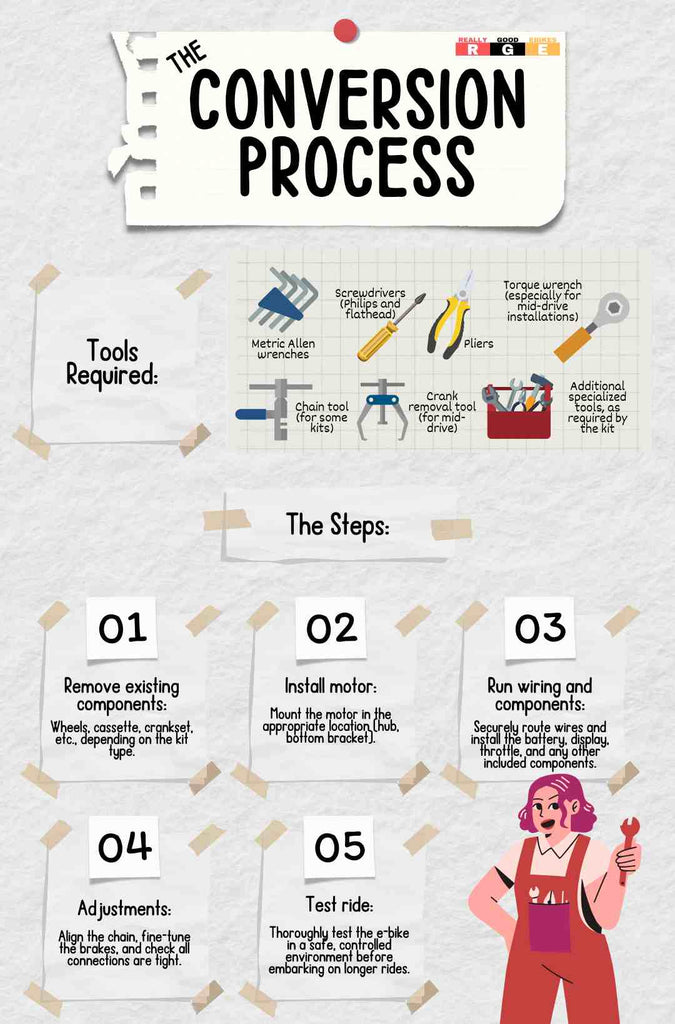
It is important to always refer to the manufacturer's specific instructions for your kit.
DIY Mistakes to Avoid During E-bike Conversion
Converting your bicycle to an e-bike can be rewarding, but common DIY mistakes can lead to setbacks or hazards. A key pitfall is underestimating the importance of an organized workspace and thoroughly reading instructions. A cluttered area increases the risk of damaging components, and skipping manual details can lead to improper connections or unsafe installations, affecting performance and safety.
Another significant oversight is neglecting proper cable management and waterproofing. Poorly routed or unsecured cables can fray, get snagged, or short-circuit, while assuming all components are waterproof can lead to damage in wet conditions. Even with water-resistant ratings, additional sealing may be needed for exposed connections. Investing in secure routing and protection for your wiring ensures the reliability and longevity of your e-bike. As Al Amin Morshed warns:
“The biggest one I see: people underestimate wiring complexity. It’s not just plug-and-play. Misplaced magnets on pedal sensors, poor controller placement, or skipping waterproof connectors often lead to intermittent cutoff or inconsistent assist. I always advise doing a dry fit first and double-checking torque specs on axles and motor mount points.”
Riding Your Converted E-Bike: Safety Considerations
Now that your bike is transformed, it's time for the exciting part – riding! Before hitting the streets or trails, it's crucial to prioritize safety. Always wear a well-fitting helmet, and consider additional protective gear like gloves and knee pads.
Familiarize yourself with the e-bike controls and practice in a low-traffic area to get a feel for how your bike handles with the added power. Start with lower assist levels and gradually increase as you get comfortable.
Importantly, research and understand the legal regulations for e-bikes in your area. Electric bike laws can vary significantly between regions and may cover aspects like maximum speed, where you're permitted to ride, and any age or licensing requirements. It's your responsibility to ensure you're operating your e-bike legally. Adhering to regulations not only protects you but ensures that e-bikes remain a welcome addition to roads and trails.
Enhance your ride even further! Explore our top-rated selection of e-bike accessories to complement your new conversion kit and elevate your cycling experience.
Legal and Regulatory Landscape for Converted E-Bikes
Converting your bike to an e-bike means understanding both federal and state laws. Federally, the CPSC defines "low-speed electric bicycles" as having pedals, a motor under 750 watts, and a top assisted speed of 20 mph. However, most states use a three-class system. Your kit's motor power and top speed will determine its classification, impacting where you can legally ride.
Class 1 and 2 e-bikes (pedal-assist/throttle up to 20 mph) are generally allowed on bike paths. Class 3 e-bikes (pedal-assist up to 28 mph) are often restricted to roads. Some states or localities may have additional rules regarding helmet use, age limits, or even require a license or registration for certain e-bike types. Always verify your specific state and local ordinances to ensure your converted e-bike complies with all applicable laws.
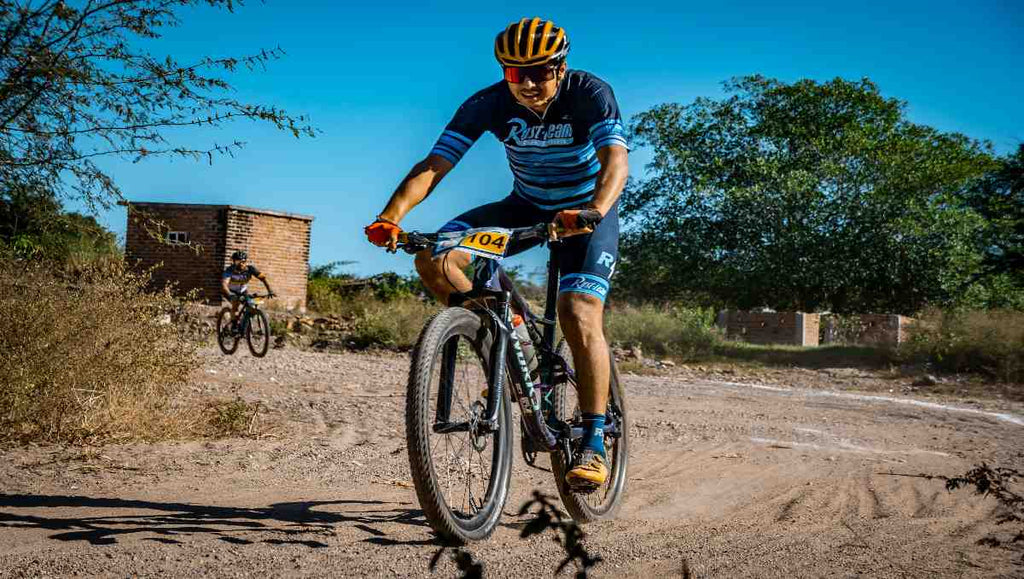
Maintenance and Troubleshooting
Taking care of your e-bike conversion kit is key to keeping it running smoothly and lasting longer. Start with battery care: avoid extreme temperatures, follow the recommended charging routine, and don’t leave the battery fully drained. For storage, aim to keep it at a 50–70% charge in a cool, dry place.
While the motor is generally low-maintenance, regular bike upkeep is still essential. Keep the drivetrain clean and lubricated, inspect brake pads, and tighten any loose bolts to prevent strain on the motor. If performance drops—like reduced range or power—check tire pressure, battery health, and all wiring connections for any signs of wear or damage.
Here are some basic troubleshooting techniques you can follow:

If troubleshooting becomes challenging, consult your kit's instruction manual or online forums, or seek help from a local bike shop. Many e-bike conversion kits include troubleshooting guides, and the online e-bike community can be a great resource for resolving common issues.
💡 Pro Tip
Use dielectric grease on electrical connectors to prevent moisture buildup and corrosion, especially if you ride in wet or humid conditions. This simple step can improve long-term reliability.
Final Thoughts
Choosing to convert your existing bike opens up a world of exciting possibilities. With the right conversion kit, you can rediscover the joy of cycling, tackle new challenges, reduce your environmental impact, and make sustainable transportation a fun part of your life. The key to success lies in finding a kit that aligns with your needs, understanding the installation process or seeking professional help, and always prioritizing safety on the road.
With careful consideration and a dash of adventurous spirit, an e-bike conversion kit can transform your regular bike into so much more. Whether your goal is to conquer hills with newfound ease or simply add a boost of fun to your leisure rides, embracing the possibilities of e-cycling will undoubtedly enrich your life on two wheels.
E-Bike Conversion Kit FAQs
Can I convert any bike?
While most standard bicycles can be converted, there are some exceptions. It's best to avoid full-suspension mountain bikes (due to complexity) and bikes with extremely lightweight frames. Always check specific kit compatibility with your bike type, wheel size, and brake system.
Is it worth converting my bike?
This depends on your goals and how much you value your existing bike. Conversions offer a more affordable entry into e-biking than buying a whole new e-bike. If you love your bike but want a boost, it could be a fantastic solution!
How much does a conversion kit cost?
Prices vary depending on kit complexity, motor power, and brand. Expect a range from a few hundred dollars for simple kits to over $1000 for high-end mid-drive systems. Factor in potential installation costs if you're not doing it yourself.
How fast can a converted e-bike go?
Laws dictate the maximum speed of an e-bike. Be sure to research the regulations in your area. Most kits are designed to stay within those legal limits for road use.
Are e-bike conversions safe?
When properly installed and operated responsibly, e-bike conversions can be safe. Always wear a helmet, start with low assist levels, and be mindful of increased speed while getting used to your e-bike.
Leave a comment
Comments will be approved before showing up.
Also in Really Good Ebikes: Electric Bike Blog
Your are successfully subscribed for email notifications.
Notify me when available
We will send you a notification as soon as this product is available again.
Your email is required
We don't share your email with anybody
x


